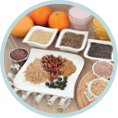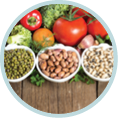Most people know that fiber is an indigestible carbohydrate that has many health benefits. It is a plant material that resisits digestion by the enzymes normally present in your stomach.
But did you know it comes in two forms: soluble and insoluble, that are wildy different?
Soluble fiber dissolves in water and forms a gel when mixed with liquid. There are many benefits of soluble fiber. It can help reduce LDL(low density lipoproteins, or the “bad” cholesterol) and it can help regulate blood sugar in individuals who have diabetes.
Food sources of soluble fiber include:
- Oats and oat bran
- Dried beans and peas
- Nuts
- Barley
- Flaxseed
- Fruits such as apples, oranges, grapefruit, and peaches
- Vegetable such as carrots
- Psyllium husk
Insoluble fiber does not dissolve in water. It passes through the intestinal tract largely intact. Insoluble fiber can speed up bowel transit time which is the time it takes for food to travel from your mouth through your digestive tract to the end of the intestine. Dietary fiber intake does affect bowel transit time and can help promote regularity and combat constipation.
Food sources of insoluble fiber include:
- Whole wheat bread and wheat bran
- Corn bran
- Peanuts and Brazil nuts
- Vegetables and fruit, especially the skins
- Popcorn
Many foods are rich in both soluble and insoluble fiber. To meet your fiber requirements, aim to eat at least 5 servings of fruits and vegetables per day as well as 6 servings of grains. The American Heart Association recommends to make at least half your grains whole grains. Examples include: 1 slice of 100% whole wheat bread, ½ cup cooked whole-grain cereal such as oatmeal, or ½ cup cooked brown rice.
Ensuring that your diet is filled with plenty of fiber can help reduce the risk of chronic health conditions such as constipation, diverticulosis, colon cancer, high cholesterol, and diabetes.
Try these easy, delicious, high fiber recipes for Tuscan Vegetable Soup paired with Tuscan Salad. One serving of soup and salad delivers 14 grams of dietary fiber!
Resources:
- An Overview of the Effects of Dietary Fiber on Gastrointestinal Transit by Craig Hillemeier, MD Pediatrics 1995; 96; 997.
- Whole Grains and Fiber from The American Heart Association